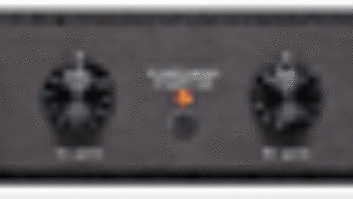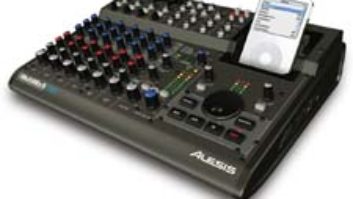Despite the kicking and screaming that ensued during the DigitalRevolution, the end result is the tasty Analog Renaissance we arecurrently enjoying. Analog tape still provides the ultimate in sonicairbag protection — digital is far less forgiving — forcing recordingengineers to pay more attention to every phase, especially tracking.Design engineers, many of whom create gear for their own use, alsore-educated themselves, hence the overwhelming number of newmicrophones and preamps, including those profiled in our report on tubepreamps elsewhere in this issue.
This month, we’ll examine some of the parameters for evaluating micpreamps, including listening tests, specification translation and atopology overview. While putting the finishing touches on this piece, Ireceived an e-mail requesting my opinion on two preamps in the $850range. The interactive investigation began with the customer lured bypromises of “warm lows” and “silky highs.” These and other words like”transparent,” “clean” and “punchy” have made their entrance and exitearly in this piece.
No review can tell you what to buy without first getting to theheart of your needs and desires. E-mail discussions tend to be briefand hot — I felt the mailer was going in the wrong direction, but whowants to hear that? It is my hope that this article lays the groundworkfor readers to conduct their own investigations.
It’s almost impossible to talk about preamps without mentioningmicrophones. The relationship is symbiotic — microphone-output levelsdetermine how hard a preamp works, hence the brief detour. Examples ofmicrophone sensitivity and preamp Equivalent Input Noise (EIN) werecollected into two tables (no “weighting”), showing these and otherspecs at a glance.
Let the games begin!
Comparing preamps is no simple task, and Challenge Number 1 issimply assembling a number of units into the same time-space continuum.Challenge Number 2: Our ears are easily misled by level discrepancies.The ear perceives louder as better, so comparisons — without firstattempting to match levels — are unfair if not outright invalid. Byleveling the playing field (no pun intended), the results become morerealistic. Embrace the scientific approach; calibrate levels tominimize the variables. That’s easier said than done, because ofChallenge Number 3: The output of one mic cannot be “multed” to severalpreamps due to impedance considerations.
Nashville engineer Lynn Fuston tackled all of the challenges duringthe process of creating a multi-CD series of preamp and microphonetests — available at www.3daudioinc.com. Fuston’s project also includedconsultations with several preamp designers until all were reasonablysatisfied with the test procedure.
D.I.Y. LISTENING TEST
Each microphone type (particularly ribbon designs) has a fairlyobvious sonic signature, so preamp surfing will require your undividedattention.
Let’s assume that you have a known reference preamp and a “typical”gain setting, a starting point that has the unit operating in its mostlinear region — good signal-to-noise ratio and ample headroom. Choosea microphone, connect to the reference preamp and feed pink noisethrough a speaker — placement between the two must be fixed andrepeatable ” and then measure the preamp with a digital meter such asthe NTI Minilyzer using the Type-C response setting. The mic can thenbe connected to each of the other preamps one at a time, matching thegain to the reference. (You can return the preamps to separate faderson a console, but this adds many more amplifiers and variables to thechain. Measure all the way through the chain.)
Before recording the results, check each preamp with your own voicewhile monitoring via headphones, flipping the Polarity switch to yieldthe “warmest” setting. This is the easiest nontechnical way to test andset polarity, while perhaps revealing one of those “mysteries” behindvocalists who can’t hear themselves. (If the headphone signal arrivesout-of-phase with the bone-to-eardrum conduction, then the sound willbe thin and distant.) Start with “softer” acoustic sources — likeguitar, voice or piano — repeating the same phrase over and over.Choose a comfortable monitoring and recording level with at least 12 dBof headroom — if ya got more bits, use ’em — and stay there.
DON’T FORGET TO BREATHE
Assuming consistent performance, listen back to each preamp. Ibelieve the more matched the levels are, the more difficult it will beto hear the difference. This assumes that the preamp is being operatedin its most linear (clean) range. Less complex sound sources — like anylon-stringed guitar as compared to wound strings — may make iteasier to differentiate between preamp-to-preamp nuances.
For the “airbag” test, start at a distance, banging a snare drum toachieve a similar level, and then move toward the mic until preampheadroom begins to run out. Optimize the level of the recordingdevice one time, taking care not to overload the inputs, becausesome preamps can generate far more level than the average DAT or CD-Rcan handle. If you get this far, congratulations (and let me know)! Formore excitement, try very high- and low-gain settings to see howpreamps behave at those extremes. If it gets too complicated and you’reexhausted, it’s okay. (That’s why Fuston made those evaluationCDs.)
SPECIFICATION TRANSLATION
Have you cruised the Net lately? There are prices and picturesgalore, but just try to correlate the wealth of information. There isno Berlitz course for translating product specs (I looked), but Neumanndoes a great job, providing a stand-alone reference area.
Because online product literature can be easily updated, it shouldbe. I found mistakes, discrepancies and vagaries. Manufacturers need topublish specs based on current measuring standards as well as providebackground information about the test procedures. Otherwise, how couldanyone compare? Assembling information was difficult enough; I can’timagine the challenge if I didn’t speak the language.
MICRO (NOT SO JOYFUL) NOISE
If noise is an issue, look at microphone sensitivity first. Table 1compares sensitivity for an assortment of large-diaphragm vocalmics. Sensitivity is specified in millivolts per Pascal (mV/Pa),typically with a 1-kohm load — the only discrepancy is in the thirdentry, the AT-3035. At 25.1 mV/Pa, it has the highest output, opencircuit, hence the bigger number.
PREAMP NOISE
A preamp in mathematical terms is a Voltage Multiplier. As such, itmultiplies noise and the intended signal. Resistors generate noise, sodo microphone capsules. EIN refers to the preamp’s input circuit noise– normally, the mic itself becomes part of the equation, but duringthe test, a 150-ohm resistor is typically substituted; its value mustbe published for this spec to be meaningful.
EIN = Gain + Noise
You can easily subtract gain from the published EIN spec to find thenoise relative to 0 dBx, where “x” is the reference. A theoretically”perfect” amplifier (one that contributes a minimum of noise) will havean EIN of -129 dBu. This means that with a gain of 60 dB, the bestpossible noise floor will be -69 dBu. Most EIN specs are measured at ornear maximum gain. Be suspicious if EIN is listed only as “A-weighted”– okay if included, but not solo. Look at the fine print if EIN isover “-129 dB.”
Note: 0 dBv is equivalent to +2.2 dBu, where “v” is referenced to1-volt RMS; “u” is ref’d to 0.775 Vrms, and, when applied to a 600-ohmload, yields 1 milliwatt, hence the “m” ref, which is based on the yeolde telephone standard.
Table 2 compares a few preamp specs. EIN is fairly consistentlyreported. Only Grace Design uses a 50-ohm source impedance (ribbon mic)rather than the more typical 150 ohms for condenser and dynamic mics.The options are un-weighted (broadband response, typically 20 to 22kHz) or A-weighted (filtered to replicate the ear’s desensitized low-and high-frequency response). The old-fashioned method was to simplymax signal-to-noise floor. The variables are source impedance(lower yields better numbers), max gain and max output.
TOPOLOGIES: LOOKING INSIDE
The contents behind the front panel can be one or more of thefollowing: tubes, transistors, transformers, discrete or IC op amps –the choice and configuration pretty much sets the “tone” of theproduct. Any of the aforementioned topologies can be nearlyindistinguishable when designed to achieve a specific goal and usedconservatively, but in many cases, “vintage disciplines” arefactored in for their character. Even the best designs can becompromised by poor production. Issues such as component quality,wiring, PCB layout and grounding are paramount to longevity, low noise,immunity from radio and television interference, and ultimately,compatibility with other gear.
GLASS CEILING: HOME ON THE RANGE
Stepping up from the noise floor, the other end of dynamic range isthe overload characteristic, of which there are three basic types –sonic airbag, “soft” clip or “windshield” headroom. The transitionbetween linear-clean and hard/nasty clipping can be wide or narrow.Remember, analog tape exhibits a gentle softening of transients that’svery forgiving. Digital isn’t, which is what your ear objects to (whenit does). Single-ended Class-A tube and transistors circuitssoft clip; however, the tube example that follows has a wider windowwhen the output circuit is loaded by 600 ohms. Ultra-clean,transformerless designs are going to hard clip when driven hard. That’swindshield headroom, just like discrete or IC op amps and digital(without “help” or DSP).
The sonic airbag is dramatically demonstrated in Fig. 1 by thesingle-ended Class-A vacuum-tube circuit in Fig. 2. Using acathode-follower output stage, it will deliver the maximum sonic airbageffect. Note that in the two examples, the distortion is always round,not edgy. Two preamps in Table 2 are likely to be contenders. Can youfind them?
BALANCING ACT
Not all vacuum-tube designs have such a broad, nonlinear region.Pultec EQs and Universal Audio’s 175 compressor have internallybalanced amplifier designs that are very linear (as are Marantz andMcIntosh power amps). Extending the linear region increases headroombut shrinks the sonic airbag. Remember, it wasn’t the intention ofvintage circuit designers to have their equipment red-lined.
HEAD OF THE CLASS
Transformers are very much a part of the vintage/retro mystique, APIand Neve being perfect examples, each known for a completely uniquesound. Class-A Neve circuits don’t have a wide nonlinear range liketubes. Depending on the load (600 ohms or not) or the Bias Adjustment– the two are interactive — the output amp can clip asymmetrically bygenerating the more musical, second-harmonic distortion beforecompletely crashing into the power rail. API’s 2520 discrete op ampuses a bipolar, Class-AB output stage that is linear to the rails.(Symmetrical clipping is great for maximizing headroom or for fuzzboxes, but for little in-between.) API’s magic comes from the symbiosesbetween the 2520 discrete op amp and its companion outputtransformer.
Note: An operational amplifier is basically a “black box”treated as a functional amplifier building block (no user-serviceableparts inside) with input, output and power connections. Op amps areessentially linear to the power rails, clipping symmetrically when theyrun out of juice, not a pretty sound, but then users are expected toknow how to set levels!
Transformers are the “static” variation of the analog recordingprocess — head + tape = transformer. Tape’s record and playback EQcurves further “enhance” the saturation characteristics, but thataside, as good as transformers can be, their distortion specs changewith frequency. Table 2 includes links to both the Great River and JohnHardy sites, where details are provided about how their high-qualityJensen Transformers perform at various frequencies.
A newer and nearly as famous discrete op amp is the Jensen 990 (usedin John Hardy preamps). A natural progression from early transistortechnology, the 990 coupled with a Jensen transformer has less “color”than the Neve or API combo. Audio started all over again when early ICop amps were introduced. They were no great shakes, but ICs reducedmanufacturing costs and increased component density, making the earlyproject studios possible as well as a vision into the future. Modern opamps are quite respectable compared to their ’70s-era ancestors.
For more information about Jensen Transformers and the 990 op amp,visit www.jensentransformers.com and go to”/apps_sc.html.”
THE WRAP
Audio engineering is like cooking: To achieve superb results,ingredients are carefully selected, added at precise times, cooked orraw ” every detail is important. And then there is fast fude. All geekmatters aside, the emphasis should always be on the production. Whileit is now more possible to achieve extremely clear and transparentrecordings, it seems that our ears like a little distortion just likeour tongue craves a little fat ” it truly is a matter of “seasoning totaste.”
Visit the Eddie archive atwww.tangible-technology.com.
WEB RESOURCES
Rod Elliott: Elliott Sound Products
www.sound.au.com/noise.htm or www.sound.westhost.com
Michael Hartkopf’s Microphone Website
www.members.aol.com/mihartkopf/faq.htm
Glossary of Audio Terminology
www.showorks.com/Library/Glossary/par-w.htm
Neumann
www.neumann.com/infopool/mics/glossary/gloss16.htm
David Josephson Engineering
www.josephson.com




